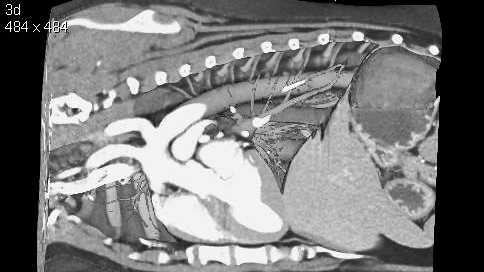1- Nephroblastoma:
Rule occurs between 6 months and 6 years; 90% of tumors of the child’s kidney and 10% of malignant tumors in children
Malformations: aniridia (no iris); hemihypertrophy body; cryptorchidism; horseshoe kidney; hypospadias (malformation of the urethra)
Metastases: lung (the most common); rare bone metastases
Treatment: chemotherapy; surgery; Radiotherapy (very radiosensitive)
Prognosis: very good (80-90% cure)
2- Neuroblastoma:
A- Semiotics:
90% before the age of 6 years; 1/3 before 1 year (sympathetic)
Hourglass tumors (NB mediastinum especially) => spinal cord compression.
Tumor metastasizing easily (60% are metastatic at diagnosis)
Bone metastases (60%); single medullary (20%); liver; lung (1%)
B- Clinic:
a- Symptoms metastases:
Syndrome Hutchinson spontaneous orbital hematoma
Σ Pepper: Wholesale liver smooth, regular, normal biology
b- Associated symptoms:
Opso-myoclonus syndrome (oculo-cerebellar myocloniq)
Prolonged watery diarrhea (VIP ++)
c- Atypical:
Prolonged fever; Cushing’s syndrome; anemia
C Diagnosis:
a- Radiology:
Pararachidiennes masses or perivascular
The presence of microcalcifications is suggestive (50%)
b- Biology:
++ Urinary catecholamines (90% of cases) (VMA)
VS ++; systematic myelogram
Bone biopsy: provision characteristic rosette
Treatment D:
Chemotherapy; surgery; radiotherapy
Pepper syndrome -> healing in 80% of cases
3- Lymphoma Non-Hodgkin:
Their treatment unit has: chemotherapy alone in all cases
Abdominal lymphoma -> 40% of childhood lymphomas; Peyer’s patch; mesenteric lymph nodes
B-cell lymphoma: Burkitt’s lymphoma; Abdominal starting point for lymphoma
T-cell lymphomas have a chest located above (-> leukemia )
Evidence: intussusception; acute intestinal obstruction; rapid increase in abdominal volume revealing)
African Burkitt: abdominal lymphoma associated with facial location (bone of the mandible); spinal cord compression signs (paraplegia). EBV + (> 90%)
Abdominal ultrasound: thickened handle giving the typical appearance rosette or sandwich. Ascites.
Systematically: CT, bone marrow aspiration, lumbar puncture
Pretreatment: uric acid, serum electrolytes, serum calcium, renal Bilan.
Main drugs: Adriamycin, cyclophosphamide, vincristine, prednisone, methotrexate.
The prognosis is good especially in case of Burkitt lymphoma
Murphy classification:
Stage I: a single tumor
Stage II: localized tumor with mesenteric ADP or 2 localized tumors
Stage III: extensive abdominal tumor or a location of both sides of the diaphragm.
Stage IV: tumor with spinal or meningeal involvement
Mesoblastic nephroma: child under 6 months (benign tumor)
Retroperitoneal tumors nephroblastoma; Neuroblastoma
Intraperitoneal tumors: non Hodgkin’s lymphoma; hepatoblastoma
The prognosis in cases of hepatoblastoma is very bad


Leave a Reply